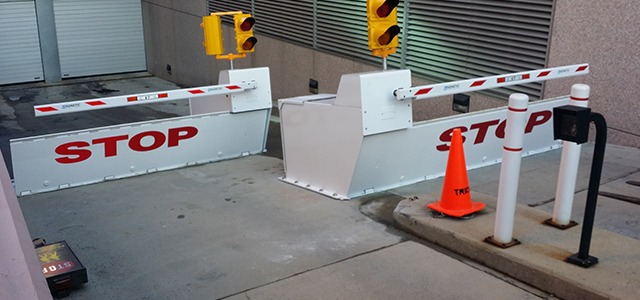Wedge Barriers Things To Know Before You Buy
Table of ContentsThe Buzz on Wedge BarriersThe Ultimate Guide To Wedge Barriers

7 Simple Techniques For Wedge Barriers
The staying pressure used to
the cam to deploy the wedge plate 16 may might provided given an electromechanical actuator 84 or other actuator. The spring setting up 54 and the actuator 84(e. Wedge Barriers. g., electromechanical actuator)might run together to equate the camera and raise the wedge plate 16.
As pointed out over, the springtime assembly 54 puts in a continuous pressure on the web cam, while the electromechanical actuator may be controlled to put in a variable pressure on the cam, consequently making it possible for the lifting and reducing( i. e., deploying and pulling back )of the wedge plate 16. In particular personifications, the constant force applied by the spring assembly 54 might be flexible. g., electromechanical actuator) is disabled. As will be appreciated, the springtime setting up 54 might be covered and safeguarded from particles or other components by a cover plate(e. g., cover plate 68 shown in FIG. 4) that may be considerably flush with the raised surface 38 of the foundation 14. As stated above, in the released setting, the wedge plate 16 serves to block accessibility or traveling past the barrier 10. For instance, the barrier 10(e. g., the wedge plate 16 )may block pedestrians or lorries from accessing a home or path. As talked about over, the obstacle 10 is connected to the anchor 30 protected within the foundation 14,

front braces 71. As a result, the link settings up 72 might pivot and rotate to allow the collapse and expansion of the linkage settings up 72 throughout retraction and implementation of the bather 10. The affiliation settings up 72 reason movement of the wedge plate 16 to be limited. For example, if a vehicle is taking a trip in the direction of the deployed wedge plate 16(e. For instance, in one scenario, the security legs 86 might be expanded throughoutmaintenance of the barrier 10. When the safety and security legs 86 are released, the safety and security legs 86 sustain the weight of Click Here the wedge plate 16 versus the surface area 12. Because of this, the training mechanism 50 may be deactivated, serviced, removed, replaced, and so forth. FIG. 5 is partial viewpoint sight of a personification of the surface-mounted wedge-style obstacle 10, illustrating the webcam 80 and the web cam surfaces 82 of the lifting mechanism 50. Particularly, 2 web cam surfaces 82, which are referred to as reduced webcam surface areas 83, are placed listed below the webcam 80. The reduced camera surface areas 83 may be dealt with to the surface area 12 (e. As an example, the reduced webcam surfaces 83 and the placing plate 85 might develop a single item that is protected to the anchor 30 by screws or other mechanical bolts. Furthermore, two cam surface areas 82, which are described as upper cam surface areas 87, are positioned over the webcam 80 and coupled to (e. In various other embodiments, stepping in layers or plates may be placed between the surface area 12 and the lower web cam surface areas 83 and/or the wedge plate 16 and the top camera surfaces 87 As stated above, the cam
80 equates along the cam surface areas 82 when the wedge plate useful site 16 is lifted from the withdrawed setting to the deployed placement. Furthermore, as mentioned above, the spring setting up 54 (see FIG. 3 )may give a force acting upon the cam 80 in the direction 102 using spring pole 58, which may minimize the pressure the electromechanical actuator 84 is needed to relate to the camera 80 in order to actuate and raise the wedge plate 16. 1 )to the deployed setting(see FIG. 4). As revealed, the webcam 80 consists of track wheels 104(e. g., rollers), which get check out here in touch with and convert along the webcam surface areas 82 during procedure.